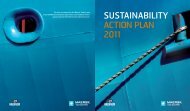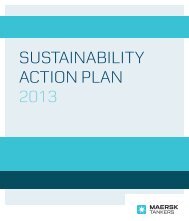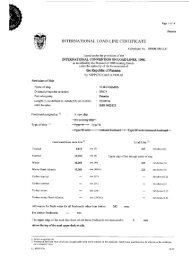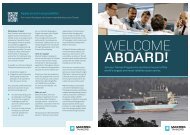SUSTAINABILITY ACTION PLAN 2010 - Maersk Tankers
SUSTAINABILITY ACTION PLAN 2010 - Maersk Tankers
SUSTAINABILITY ACTION PLAN 2010 - Maersk Tankers
You also want an ePaper? Increase the reach of your titles
YUMPU automatically turns print PDFs into web optimized ePapers that Google loves.
November 2009<strong>Maersk</strong> <strong>Tankers</strong> & Broström Sustainability PoliciesAt <strong>Maersk</strong> <strong>Tankers</strong> & Broström we recognize that asustainable future is integral to the way we conductour business. We place a high priority on the health,safety and security of our employees and assets andthe well being of all those contributing to or affectedby our operations. We are committed to the protectionand conservation of the environment and we aim tointegrate sustainable thinking and corporate socialresponsibility into all our business processes andbusiness relationships.awareness and training. We aim to continuouslyreduce emissions, optimise our operations, avoid harmto the environment and to find innovative & timelyimprovement solutions.Place „Mirror“ hereWe promote the health, safety and security of all ouremployees through raising awareness, managing risksand changes with prudence, promoting a strong safetyculture, setting appropriate goals and continuouslyimproving the skills and competencies of our people.It is the objective of <strong>Maersk</strong> <strong>Tankers</strong> & Broström toprovide a healthy work place promoting healthy workpractices and a healthy lifestyle for all persons involvedin our business.We are focused on the protection of the environment andsustainable development, by means of managementcommitment, motivating our employees, target setting,Steffen JacobsenPresident, Broström FranceVice President, TechnicalDirector, <strong>Maersk</strong> <strong>Tankers</strong>Søren SkouPartner and Member ofthe Group Executive BoardWe recognize that our operations are far reaching andhave global influence. With this in mind we will workdiligently with our employees, local communities andinternationally recognized bodies to ensure that socialfactors are integral to our business principles.We assure consistent and best in class quality inour services to external and internal customersthrough efficient yet safe operations, developmentof our employees, and rigorous monitoring of ourperformance. We promote continuous improvement asa principal driver by knowledge sharing practices andtimely review of our management systems.This Policy statement is in support of the <strong>Maersk</strong>Fundamental Business Principles and our Core Values.The <strong>Maersk</strong> <strong>Tankers</strong> & Broström Sustainability ActionPlan supports the ambitions of this policy.Robert UgglaPlease take a good look in the mirrorWhy? Because this is the person who isresponsible for your personal safetyPersonal Safety can be achieved by one of two mindsets "I have to" OR "I choose to".Which one do you think applies to you ?Seafarers that maintain an "I have to" attitude to safety simply follow instructionsas a matter of compliance, to the minimum standard required and are more likely toexperience accidents with time.Seafarers that develop an "I choose to" attitude to safety, do so because they want tobe the best in the business. They carry out work related tasks correctly, and are able gohome after a voyage in the same healthy condition as they came on board.Accepting responsibility must be recognised as an opportunity for improvement– another step toward excellence.Learn to look out for yourself AND each other, and you'll have a workplace where nobodygets hurt - and that's something we can all live with.Managing DirectorBroström AB, Goteborg2 3
<strong>SUSTAINABILITY</strong> STRATEGYWhat do we think about when developingthe Sustainability StrategyValues and principles• Which issues are material to our business?- environment, safety, CSR, employment andlabour• We need to prioritise areas where we are most atrisk and have the best business opportunities tosupport our Business Strategies?• What are our customers’ priorities?- safety, environment, costStakeholder engagement• Who are our most important stakeholders?- employees, customers- class.• How do we ensure that we understand theirpriorities and concerns?And that they understand ours?- employee engagement surveys, vettingmanagement systems, tenders.Accountability and transparency• Which metrics will measure performance of ourstrategy priorities?- accident stats, environmental damage, audits,vettings, retention rates, sustainability compassWhat we have to recognise is our strategy is a longterm one in line with the BU strategy.The integration of Broström <strong>Tankers</strong> has provided anopportunity to relay onto those vessels all the goodprojects and operations that <strong>Maersk</strong> <strong>Tankers</strong> hasbeen running for years, such as implementation ofthe <strong>Maersk</strong> Ship Performance System.For an overview it’s been decided that the followingfive areas will be prioritised during the comingyears. These areas when addressed, will give us thecompetitive edge required by showing true sustainableleadership.1 Management commitment• Clear communication of environmental/CSR commitment from Top Managementto all employees• Top Management externally communicateenvironmental/CSR targets2 Supplier management• Collaborate with ‘strategic partners’• Minimum sustainable requirements tosuppliers• Ensure we have an influence on NewBuildManagement3 Integrate sustainabilityas a part of our business• Set and achieve high safety standards.• Establish local integrated environmentalorganisation• Total business impacts taken into accountin the decision making process• Set high but achievable targets such as15% relative CO 2 reduction by 20154 Partnerships with customers,academia & clean-tech companies• Be in the forefront with new technologies.Strong collaboration with innovationdepartments.5 Internal and external communication• Continuously enhance our communicationon good sustainable performance.Benefits from proposedstrategyCost savings and cost avoidance• Proposed investments will save fuel, lower climateimpacts and avoid compliance costs.Competitive edge• Moving cargo more cost effective and moresubstainability friendly.Positioning• Recognised as a sustainable leader in the tankerbusiness.• Assist governing bodies on developing futureregulations.Creates business opportunities• Ensure our strategy and operations support theBusiness Strategy and continuously work in accordwith the commercial departments to leverageopportunities.Engaged employees• Sustainable development will attract and retainskilled employees. Our employees have manyideas and solutions and we need to ensure thatwe have the right people in the right positions toinfluenze New-build Design and Management.8 9
What you don’t measureyou cannot manage” “ENVHSSCSR<strong>SUSTAINABILITY</strong>COMPASSWe are introducing a new and aligned performance measurement system for <strong>Maersk</strong><strong>Tankers</strong> and Broström. This will include 'balanced scorecards' to measure the overallperformance by our Vessels, Fleet Groups and Marine Standards.To help increase focus in Key areas for a sustainable business, the compass is beingintroduced to visualise the Marine Standards Performance.This sustainability Compass represent the following four main areas of our Sustainability strategy- Health, Safety and Security, Environment, Corporate Social Responsibility, Quality.QUAIt acts as a Balanced Scorecard which consists of some of the KPIs listed below and will show our progresstowards our targets. It is also a useful tool for recognizing areas that require increased focus or a strategicchange during the year.As most of the KPI's included have a risk element, the compass also gives us an overview of our risk from asustainability point of view where a high performance indicates a low risk.Why a Compass?The compass allows ships to steer a selected course and by taking bearings of visible objects with a compass,a navigator is able to fix the ship's position aiding to safe sailing en route.The reliability of a magnetic compass is undisputable and has always been a true guiding tool and is thereforechosen as a natural metaphor for our Sustainability Performance.Past performance and future targets - QualityKPIs – Key PerformanceIndicatorsAll the past performance and targets discussed within this table and thefollowing plan pertain to <strong>Maersk</strong> <strong>Tankers</strong>; however the targets here-onwill be applicable for both the Broström Fleet and <strong>Maersk</strong> <strong>Tankers</strong>. Newlyintroduced KPIs are marked with a *.Performance2008Targets2009Performance2009LTI – Lost Time Incidents 16 0 9 0Targets<strong>2010</strong>LTIF – Lost Time Incidentsfrequency1.38 0.6 1.06 0.6TRCF – Total RecordableCase Frequency3.53 2.50 3.19 3Incidents (excluding spills) 41 0 32 0Near Misses report per vessel 26.7 24 28.4 36Oill Spill (Overboard) 3 0 2 0Oil Spill (Contained) 4 0 9 0APMM Valid Averageobservations5.0 5 4.2 4.5from SIRE inspectionsHigh Risk Observationfrom SIRE0.3 0.3 0.3 0.3PSC – Port State Control– Detentions0 0 1 0PSC Port State Control– Def per inspection0.4 0.5 0.6 0.3Sea Staff Attrition rate 11.1% 9% 9.20% 8%MLC – Maritime LabourConvention*New KPI New KPI New KPI 4.510 11
Action Plan <strong>2010</strong>TITLE Objectives Targets <strong>ACTION</strong>SInvestigate the standards of theAnalyse and then improve the- Working environment1impact that life on board a vessel- Recreational environmenthas on seafarers health.Health Campaign- Food2Mooring Campaign3Ship Safety OfficerCourse4Behavioural Safety5SafetyPerformance6Rest HourViolations8Security Training9Security Training10Security DrillAccident Analysis has identifiedMooring Operations as an areafor improvement.Fleet feedback has requestedfurther information regarding theroles of Ship Safety Officer.Adopt the concept of BehaviouralSafety.Maintain a high level of SafetyPerformance KPI’s.Reduce the number of Rest HourViolations experienced by thefleet.Ensure that abs and officersreceive onboard CBT (ComputerBased Training).Ensure that all personnel onboardthe vessels going through highrisk areas have been trainedin Surviving piracy and armedrobbery Course (SPAR).Quarterly security drill (tabletop)involving the CSO (CompanySecurity Officer) from each office.Give sea farers an improvedknowledge into the safety aspectsrelating to Mooring Operations,therefore reducing the accidents.Provide all Officers and Cadetswith a training tool that will detailthe task involved in the role ofSafety Officer and give themguidance in how to carry out therole.Improve safety performance andreduce the number of accidentsthat occur.- Achieve a LTIF of 0.6- Achieve a TRCF of 3.0- Near Miss Reports3/vessel/month- Unified Safety PerformanceAchieve a continually improvingnumber of violations per monthover <strong>2010</strong>.All on board have “on boardsecurity training certificate”.All crew passing Owners identifiedHigh risk areas have the relativeCBT certificate.Drill for all office locationsinvolving vessels.Provide a report on the analysisperformed with guidance forimprovement.A Mooring Campaign DVD will bedistributed to the fleet.An interactive CD-Rom will bedistributed to the fleet.In addition to the currenthardware and software toolsin place to maintain safetyperformance, Behaviour will beanalysed and used to improvesafety performance.Knowledge sharing will beperformed throughout theorganisation so that all <strong>Maersk</strong>Tanker and Broström vesselsmeet our performance targets.Use the rest hour analysis andfeedback from the fleet tominimise the number of rest hourviolations experienced.An interactive CD-rom will bedistributed to the vessel (if theSSO (Ship Security Officer) doesnot have one already).An interactive CD-rom willbe distributed to the vesseltransiting the areas.Vessel provide Security trainingcheck list to their SSO.1415
EnvironmentWe are a part of the problem, but also part of thesolution. We ensure continuous improvementof our environmental performance by settinghigh but achieveble targets such as 15% relativereduction in CO 2 by 2015.Past PerformanceThe general trend of our performance is that we haveimproved the scale of our environmental impactfrom 2007 to 2008. The main contributing factorsto the improvement in our performance are a rangeof focused efforts to limit for instance fuel consumption.The trend in emissions of SOx, NOx, and PM fromships under the <strong>Maersk</strong> <strong>Tankers</strong> control is stable,even though the numbers reported have grown dueto improvements in the amount and quality of data.Key Success Causing ActionsSeveral achievements in regard to environmentalperformance were made in 2008/2009:• ISO14001 training has been distributed to allvessels and very positively met. More than 900officers, cadets and shore staff have completedthe training.• The US environmental compliance programmewas successfully completed with great satisfactionfrom the US requirements.• A sludge/garbage reporting system for alltanker vessels was launched in order to ensureenvironmentally responsible waste landingfacilities in ports. More than 70 ports have beenenvironmentally rated• Green Passport has become part of the newspecification on all tanker vessels except LNGcarriers.• Internal audits/ surveys have been initiated,e.g. <strong>Maersk</strong> Global Fleet Support, Gallagher MarineSystems and Selected new building shipyards.• Key office personnel have been trained in oilspill response in order to improve shore-basedpreparedness in case of a major incident.• First group wide APMM HSSE report was publishedexternally.• Green award granted to <strong>Maersk</strong> Rosyth• Reduced the total Specific Cylinder Lube Oilconsumption by 5 % in 2 months.• Reduced CPH and Paris Broström Vessels CylinderLube Oil consumption by 12 % in 2 months.• Base Load reductions of 25 % = 0,8 MTHFO =2,56 MT CO2 pr day achieved on test vessels byoptimizing procedures.• CLT propeller Fitted on Roy <strong>Maersk</strong>. Expectedemission reduction of 5-7 %.• VTG Turbo Charger installed on <strong>Maersk</strong> Kalea.Expected emission reduction of 3 %.• Fuel Oil Sliding valves retrofitted on 12 Vessels.NOX emission reduction of 30 %• Electrical Steam generators fitted on 7 Vessels,approximately 30 more to come. Expect 35 %reduction of emission during Port stay.Future Targets– Environmental Strategy for <strong>2010</strong>To ensure a continuous improvement of ourenvironmental performance, objectives and targetsare established and revised on an annual basis.The environmental objectives and targets involveeveryone in the MTTO, and those on board thevessels. We must work together to achieve ourcommon goal, which is to reduce consumption ofresources, emissions and pollution and aid in our aimfor Eco-Efficiency. In addition to the environmentalobjectives and targets below, all vessels haveestablished vessel-specific objectives and targets forimprovements.Our long term strategy will focus on the followinggoals. We will work hard to become a true environmentalleader through the integration of sustainabilityas a part of our business. Focus areas are:• Air Emission Reduction Targets• Waste Management• Sustainable use of Resources• Chemical Management• ISO14001 for combined fleet• Increased Environmental Management andAwareness (shore and seafarers).What defines Eco-Efficiency?<strong>Maersk</strong> <strong>Tankers</strong> aspires to go beyond compliancein order to gain competitive advantage througha systematic approach to identify potentials formore efficient use of resources, lower emissions andoptimize cost and also a proactive mitigation ofenvironmental risk<strong>Maersk</strong> <strong>Tankers</strong> will place itself to anticipateregulatory changes as well as customers' andcompetitors' moves.1617
Action Plan <strong>2010</strong>Title Objective Target Actions1Air emissions2Fuel OptimisationProjects3Sustainableuse of resurces4Oil pollutionReduce airemissionsSpecific <strong>Maersk</strong><strong>Tankers</strong> projectsto be rolled out tointegrated <strong>Maersk</strong><strong>Tankers</strong>/Broström<strong>Tankers</strong> FleetPlan useof energy ,technology andtransport toachieve maximumbenefit for minimumexpenditureof resources.Minimizing oilpollution riskReduce oilywater dischargefrom daily vesseloperationReduce CO2 exhaust emissionsper cargo unit x nautical mile by5 % by 31st Dec. 2012 from 2007levels.Reduce CO2 exhaust emissionsper cargo unit x nautical mile by15 % by 31st Dec. 2015 from 2007levels.Reduce emissions of NOx percargo unit x nautical mile by5 % by 31st Dec. 2012 from 2007levels.Average annual sulphur contentin fuel on maximum2.5 % for tanker vessels.Reduce VOC emissions fromcargo on tanker vessels.Reduce VOC emissions fromcargo on tanker vessels.Reduce HFO/MDO/CLOconsumptions.Continuously reduce environmentalimpacts of tanker vesseloperation.Zero incidents which haveimpact on sea or land from fuel,oil transfer and operation ofequipment.Install stern tube type on all newtanker vessels not discharging oilto environment.Install 5 ppm filters in bilgewater discharged to the sea to(MARPOL: max 15 ppm) beforethe 31st December <strong>2010</strong>.• Delivery of 4 VLCC’s with waste heat recovery systembefore 31/12-2012.• Continuously improve voyage planning, optimal trim,polishing.• Optimal cargo heating means & Instruction• Evaluate boiler design on B&R type vessels.• Continual assessment of speed/consumption.• Evaluate potential for new scrubber technologies.• Delivery of 4 VLCC’s with waste heat recovery systembefore 31/12-2012.• Analysis of all fuel bunkers before consumed.• Technical adjustments to ensure all relevant vesselscan operate low-sulphur fuel. All LNG vessels vesselrun on LNG fuel.• Investigate possibilities in exhaust gas recirculation.• Develop approved VOC management plan for allcrude carriers before July 1st <strong>2010</strong>.• Develop approved VOC management plan for allcrude carriers before July 1st <strong>2010</strong>.• Enhance crewawareness.• Improve the MSPS dataquality.• Hull cleaning• Trim optimization• ME SFOC optimization• Base Load reduction• Steam systemoptimization• Cylinder LO reduction• Voyage Planning.• ME Slow Steamingoptim.Monitor the operational performance of the vesselsand take corrective actions when discrepancies arefound.Contribute to the economic use of materials andenergy through improved design, increased efficiency,better process control and use of recyclable materials.Up to date Emergency Response Plans are in place.Emergency Response Plans are tested at leastbi-annually for vessels and shore functions to validatethe capability to respond to significant emergencyscenarios.Installation of stern tube seal air type system.Contribute to improved design, increased efficiency,and better process control of bilge water treatment.Title Objective Target ActionsEnhance ballastEvaluate ballast treatment5water management.technologies on tanker vessels.Ballast water6Wastemanagement7Ntifouling paint8Chemicalmanagement9Environmentalmanagementand awareness10Vesselrecycling11CustomerrequirementsReduceenvironmentalimpact of wastedisposal.Reduce theenvironmentalimpacts fromantifouling paint.Reduce environmentalimpactsfrom paints andchemicals.Deepen theunderstandingregardingenvironmentalissues in shippingand ISO 14001amongst sea staffand office staff.Prepare vesselsfor environmentallyresponsiblerecycling.Meet customerrequirementswith regards toenvironmentalissues.At least 10% of all garbagelanding shall happen in portsrated green by end of <strong>2010</strong>.Continuously monitor the effectson fuel consumption for differentantifouling paint alternatives.Enhance awareness regardingminimization and substitution ofchemicals.More than 500 seafarers shouldhave completed the ISO14001training course before end of<strong>2010</strong>.Enhance environmentalawareness for shore-bastedpersonnel.Achieve Green Passport for allnewbuliding and for minimum 3existing Crude, Product per year.Environmentally responsiblevessel recycling.Be in the forefront of industrywith regards to environmentalissues.Continuously monitor and make feasibility studies forballast water treatment systems.Carry out mid-ocean ballast exchange wheneverpossible.Rate most used ports in new sludge/garbage system.Continuously monitor fuel efficiency on tankervessels and be on forefront with new environmentaltechnologies.Initiate project regarding substitution and optimizationof chemical use, including a guideline in optimalhandling of paint and chemicals by 1st July <strong>2010</strong>.All officers and cadets should complete course at theirfirst sign-on whenever possible.Include environmental familiarization script inintroduction binder for all new <strong>Maersk</strong> <strong>Tankers</strong> andBroström Employees.Have class surveyors approve vessels inventory list forselected new built vessels and issue Green Passports.Have a SOP for environmentally sound recycling onvessels available by July 1st <strong>2010</strong>.Continuous improvements of our environmentalperformance and environmental benchmarking withindustry.18 19
„Wenn die Hände ein Wiegenlied singen …“Einführung in Rhythmische Einreibungen nach Dr.Hauschka. Mit sanften und ruhigen Berührungenkönnen Sie Ihrem Kind Wärme und Hülle schenken:Bei Unruhe und Schmerzen, als Ritual nach der Pflege,zum Einschlafen ….KursleiterHermann Glaser, Gesundheits- und Krankenpfleger,Ausbilder für „Rhythmische Einreibungen“Termine / KostenEinführungMontag, 07. Oktober 2013, 20.00 UhrPraxis an Babys, PuppenMittwochs, 09. und 16. Oktober 2013, 16.00 – 17.00 Uhr6 Euro (Einführung), 10 Euro pro NachmittagVeranstaltungsortFilderklinikAnmeldungInge HeineFon/Fax 0711/99 726 40Mo – Fr., 8.00 – 8.30 UhrE-Mail inge.heine@arcor.deKurse rund um die Geburt und Kindheit11
CSR StrategyIt has been decided that we should have anambitious yet tangible strategy when it comes toCorporate Social Responsibility. A gap analysisundertaken in early 2009, outlined specific actionableitems we would need to address to satisfy the10 principles of the UN Global Compact. Manyof these actions are on a Group level, however in<strong>Maersk</strong> <strong>Tankers</strong>/Broström, we have the importanttask of implementing these actions and mostimportantly ensuring our organisation is capable offulfilling these actions.The Maritime Labour Convention 2006 is aninnovative , integrated approach to ensuring decentwork for all seafarers, wherever they come fromand whatever the national flag of the ship on whichthey work. The International Labor Organisation hasrecognized that poor working conditions and qualityshipping cannot go together. The Convention setsminimum requirements for seafarers to work on aship and contains provisions on conditions ofemployment, accommodation, recreational facilities,food and catering, health protection, medical care,welfare and social security protection.Based on gap analysis taken place during 2009,areas of improvement have been identified and<strong>Maersk</strong> <strong>Tankers</strong>/Broström will focus on implementingthese areas during <strong>2010</strong>.Our goal is to have an CSR strategy thatmeets the following criteria to ensure BusinessIntegration :• Top management involved & committed• Integration in business strategy• Engaged with civil society• Anticipate change• Systematic management• Embedding Sustainability mindset• Focus on new opportunitiesTo ensure we meet our goals, in <strong>2010</strong> we will focus onthe following actions.CSR Actions for <strong>2010</strong>TITLE Objectives TITLE ObjectivesThe objective is to set consistent standards in alignmentwith the 10 universal principles of the UN Global Compact on1 human rights, labour rights, environment and anti-corruption 2Responsible for business partners and suppliers across the Group. Establish Anti-CorruptionProcurement the third party code- Implementation guides, SOP’s.Policy3LabourRightsCreate an attractive working environment through HR policiesreflecting the tanker industry, secure diversity, improve theEES process and reputation in thejob market.4BaselineData for SustainabilityReportImplementation ofAnti-Corruption Policy.Clear defined guidelines onFacilitation payments.With Group HSSE,develop set of leading KPI’sto determine our baselinedata sets.22 23
Quality and VettingBoth Process Quality and Service Quality have beenof pivotal importance in <strong>Maersk</strong> <strong>Tankers</strong>/Broström.For the purpose of adequately controlling the Qualityof our processes, we have in place documentedprocedures system which have been undergoinga gamut of changes to incorporate the series ofOrganization changes in the recent past.The TGSMS (Tanker Global Ship ManagementSystem) (which is a derivate of the GSMS) is <strong>Maersk</strong><strong>Tankers</strong> current procedures system. However withthe acquiring of Broström, the system is boundto undergo a complete revamp as we integrateBroström procedures with <strong>Maersk</strong> <strong>Tankers</strong> ones.Quality Performance – <strong>Maersk</strong> <strong>Tankers</strong> 2009Along with this to improve usability onboard vesselsand to increase the interaction between our manysoftware tools, we have decided to move our proceduressystems and several other programs to anumbrella system called the Shipnet. The estimatedtime of completion of this project is early 2011.There’s no doubt that the present times require extraefforts from the <strong>Maersk</strong> <strong>Tankers</strong> and Broström familyas we work towards stability while integrating change;but once we do all the right things going along – weare sure to emerge far stronger than ever before.KPI Target 2009 Result 2009 Targets <strong>2010</strong>APMM Valid Avg obs from SIRE inspections 5.0 4.2 YTD 4.2 YTDHigh Risk Observations from SIRE inspections 0.3 0.3 YTD 0.3 YTDOff service time 48 hrs/vsl 62.12 hrs/vsl YTD 48 hrs/vslPSC Detentions 0 1 YTD 0 YTDPSC Def per inspection 0.5 0.6 YTD 0.3 YTDPMS Overdue activities
Vetting Action Plan - <strong>2010</strong>Title Objective Target ActionsShare best practices from vessels1Share best identified as top-10 vettingpractices.performers through the VIMSVettingvetting benchmarking system.Excellence2Analysis andreview3Inspectionand auditphilosophy.4Trainingof internalinspectors andauditors5Adopt bestpractices6CustomercontactImprove vettingperformance.Continue todevelop theproven MTTO(<strong>Maersk</strong><strong>Tankers</strong> TechnicalOperations)inspection andaudit philosophy.Align standardsof the conductof internalinspections andaudits.Make full use of3 rd Party fleet datafor benchmarkingand adopting bestpractices.Create morevisibility in theindustry.Thorough analysis / review ofall actionable data to drive improvement(through campaigns)and ensure accountability withinorganization.Propagate the proven MTTOinspection and audit philosophy.Ensure that most value is addedfrom the internal inspection andaudit programme.Incorporate best industry targetsin own SMS (Ship ManagementSystem).Lead the industry development.Roll out ‘Vetting Excellence Campaign’.Analysis and review in Monthly Vetting Reports.Seamlessly tie up the Tanker Vessel Self Assessment+ internal inspections with the external inspections.Perform quarterly inspection and audit trainingsessions.Analysis and review to be carried out of 3 rd Partyfleet data.Participate in various industry forums such asOCIMF (Oil Companies International Marine Forum)and SIGTTO (Society of International Gas <strong>Tankers</strong> &Terminal Operators) and visit key customer vettingdepartments.2627
Vessel HSE action planIn the year <strong>2010</strong> we look forward to moreconsistent HSEQ KPI reporting from Vesselsand stronger follow-up of the same by MarineStandardsThe Vessel HSEQ KPIs reporting was started in2007 and is done via the IFORMs 263 and 262. Theobjective is to raise onboard ownership through selfperformance tracking which in turn will impact theHSEQ performance of vessels and in turn <strong>Maersk</strong><strong>Tankers</strong> and Broström. This ownership along witha focused overview shoreside should lead to theimplementation of valuable KPI's now and movingforward.Past Performance13 ships have not reported performance in 2009(neither IFORM 262 nor 263)Of those that have reported, 22 ships have not sentin IFORM 262 i.e. details of self initiatives.At the end of 2009, we will compile a report on thevessel HSE action Plan and Objectives performancewith the above statistics and more.ObjectivesWe have decided to continue with almost the sameplan for 2009-<strong>2010</strong> since the IFORM 262 requiresvessels to implement self initiatives which may takea while to bear fruit. Though most objectives remainthe same, we’ve added 1 new KPI under bullet 8. The8th KPI is Training of Safety Officers – Under thisall Officers must undergo a Safety ManagementTraining, CDs of which will be dispatched in January<strong>2010</strong>.Sr.No.FleetHSEQ KPIsTarget1 Near-miss reporting: 6/qtr2 Health and Safety Initiatives 4/yr3 Ship Specific SJAs reviewed 2/vsl/month4 Rate of Valid Sire observations
Glossary of termsAccident - An undesired event, or series of events,that results in injury or illness to people.Audit - A systematic and independent examinationto determine whether activities and related resultscomply with the Management System and whetherthe system arrangements are suitably implemented,and documented to achieve the desired objectives.CSR – Corporate Social ResponsibilityFatality - A death directly resulting from a workrelated injury regardless of time between the injuryand death.HSEQ - Health, Safety, Environment and Quality.HSS - Health, Safety and SecurityIncident - An undesired event that results in harm topersonnel (injury or illness), environmental damage,property damage/loss, or business interruption (lossof process) that may have an adverse impact on<strong>Maersk</strong> <strong>Tankers</strong> or Broström.Incident Frequency – cases multiplied by 1 million,and divided by the number of exposure hours.Allows for comparable measuring of incident types.Eg• (Number of LTIs) x 1,000,000Exposure hoursKPI- Key Performance IndicatorLost Time Injury (LTI) - Any work related injury otherthan a fatal injury which results in a person beingunfit for work for a period of 24 continuous hoursimmediately after the occurrence of the incident.This period includes rest hours, discharge andsign-off days, weekend days, public holidays or daysafter ceasing employment.Medical Treatment Case (MTC) - Work-relatedinjuries that are not severe enough to be reported asfatalities or Lost Time Accident cases or RestrictedWork Accident cases but are more severe thanrequiring simple first aid treatment i.e. treatmentby a doctor, physician, dentist, surgeon, registeredmedical personnel or Radio Medical advice, howeverthe injured person is able to carry out all his dutiesafter treatment.A mission statement is a brief description of<strong>Maersk</strong> <strong>Tankers</strong> and Broström Technical Operationsfundamental purpose. A mission statement answersthe question, “Why do we exist?”Near Miss - An event or sequence of events whichunder slightly different circumstances could haveresulted in harm to personnel.Non-conformance - An observed situation whereobjective evidence indicates the non-fulfilment of aspecified requirement.PMS - Planned Maintenance System.PSC - Port Stable ControlPersonal Protective Equipment (PPE) - Allequipment and clothing intended to be utilised,which affords protection against one or more risks tohealth and safety. This includes protection againstadverse weather conditions.Restricted Work Accident (RWA) - Any workrelatedinjury other than a fatality or lost timeaccident which results in a person being unfit toperform duties within their normal work role andperformance of the regular job after the occurrenceof the incident.Risk Assessment - The proper identification,measurement and prioritising of risk. Also known asSafe Job Analysis (SJA).SOP - Standard Oprating ProceduresSustainability - sustainable development isdevelopment that meets the needs of the presentwithout compromising the ability of future generationsto meet their own needs. In essence we shouldmanage our resources efficiently to ensure futureprospects.Total Recordable Cases (TRC) - The sum of allwork-related fatalities, Lost Time Injuries, RestrictedWork Accidents and Medical Treatment Cases.TRCs = Fatalities + LTIs + RWAs + MTCs.Vision – The picture of Maerk <strong>Tankers</strong> in the future3031
This plan is prepared by the <strong>Maersk</strong> <strong>Tankers</strong> & BroströmMarine standards department, any feedback and/or queriesmay be directed to CPHTANKTOADM@maersk.com.





